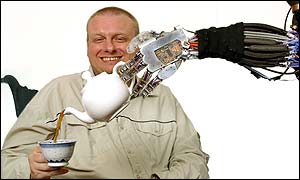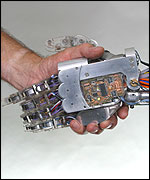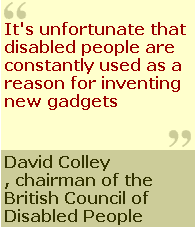|
Wednesday, 7 August, 2002, 23:11 GMT 00:11 UK Robot hand for the disabled
The arm pours a cup of tea
Getting a glass of water in the night could soon be far easier for disabled people - a robot could do it for them. A UK company is developing a robotic arm, which fully mimics a human hand.
It is hoped the programming needed to make a prototype arm which can fetch a drink could be completed within a year.
The Shadow Robot Company, based in north London, hopes eventually to develop a robot that can perform a wide variety of tasks for disabled people.
It has just received an invention and innovation award of Ł75,000 to help develop the robot from the National Endowment for Science, Technology and the Arts (Nesta).
But disabled campaigners said a robot was no replacement for flexible, human, personal assistance.
The arm can already pick up a glass and hold it.
Richard Greenhill, managing director of the Shadow Robot Company, told BBC News Online the grant would allow work on the complex navigational and knowledge programme needed.
"It has to know everything such as where the cupboard is and how to open the door."
Air muscles
"Our device is different in that it's got all the movements of a human hand.
"Nasa has got a hand with 12 movements. We have done all 24, so we're a significant step ahead."
It's unfortunate that disabled people are constantly used as a reason for inventing new gadgets.
The secret of the robot is using air muscles rather than electric motors to power the movements. All the air muscles can fit into a forearm.
They are a rubber tube inside a special braiding. If the tube inside gets fatter, the braiding gets shorter.
It will have a hand and arm on a moving base, with remote control and camera systems, so the user can guide the robot through simple tasks.
Eventually computer software will allow the robot to perform tasks automatically.
Richard Walker, technical advisor at the company, said: "The aim of this is to make a robot that's helpful to a person that needs assistance on a daily basis, things that they could feel were too trivial or embarrassing to ask a person to help with."
He said the robot could provide a safer and more convenient alternative to a person carrying out a task themselves.
Mr Walker admitted a robot could cost as much as a car, but said a disabled person could pay for it gradually over time.
Social benefits
He said a complete robot assistant could be just two to three years away.
Jeremy Newton, chief executive of Nesta, said: "The robot has real commercial potential for the assistive aids markets as well as offering substantial social benefits by empowering and enabling both the disabled community and an increasing ageing population."
But David Colley, chairman of the British Council of Disabled People, told BBC News Online: "It's unfortunate that disabled people are constantly used as a reason for inventing new gadgets."
"Disabled people are quite clear that we need adequate support and personal assistance which is flexible.
"This is not only to do the basic tasks, but also to do other, more sophisticated tasks, which are essential to our well being, such as getting out of the house, meeting new people and having genuine control over our daily living."
|


